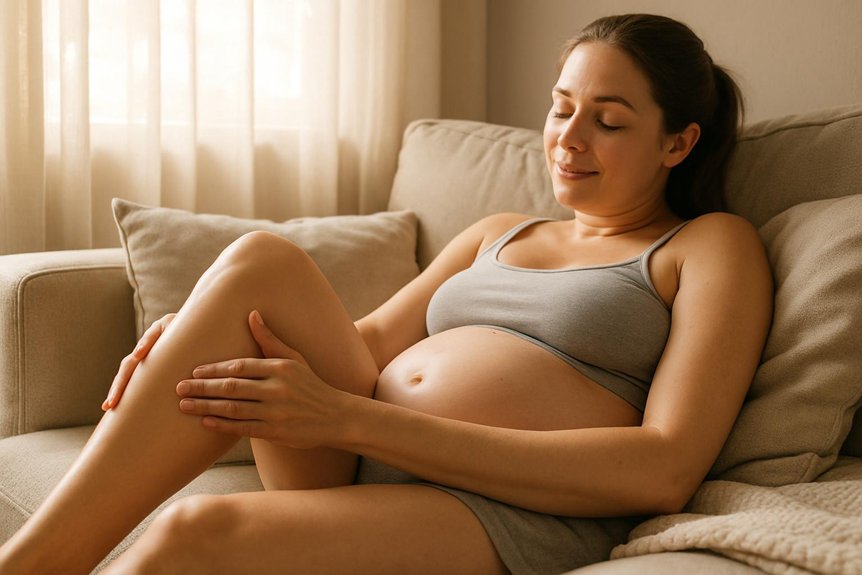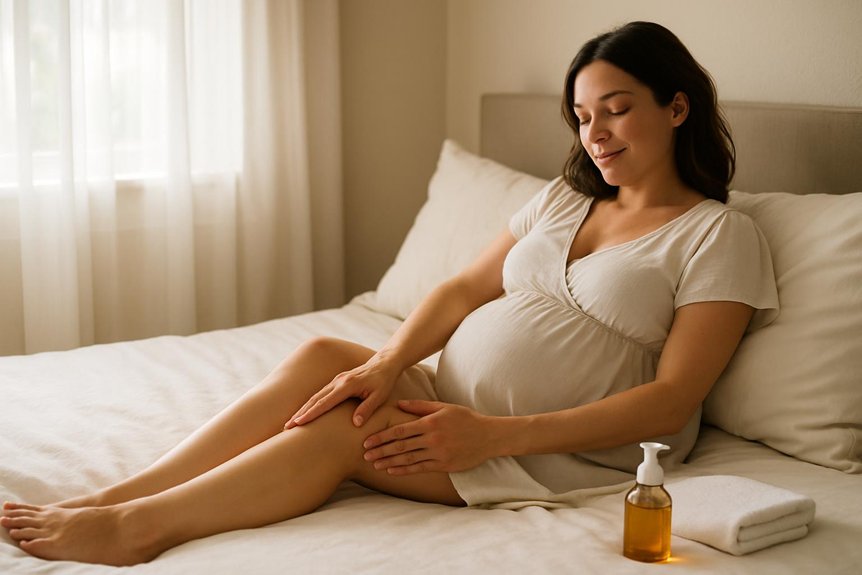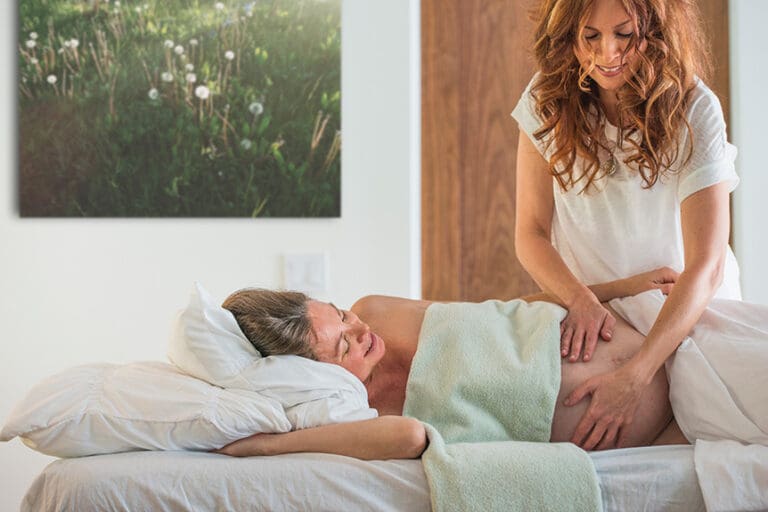Leg massage in pregnancy is generally safe and helpful when uncomplicated and performed gently. Use side‑lying or semi‑reclined positions with pillows. Apply light‑to‑moderate, slow strokes; avoid deep pressure, inner‑thigh compression, varicosities, and any abdominal pressure. Screen for red flags such as unilateral calf pain, swelling, shortness of breath, hypertension, bleeding, or fever, and stop if symptoms arise. Pregnancy‑safe oils and hydration are advised. Benefits include reduced edema, cramps, and better sleep. Further details clarify techniques, oils, positioning, and aftercare.
Is Leg Massage Safe During Pregnancy?

When performed by trained practitioners and adapted for each trimester, leg massage is generally considered safe in uncomplicated pregnancies. Safety hinges on appropriate positioning, pressure, and oil selection.
At Spa & Massage clinics in London, therapists use side-lying or semi-reclined positions, avoid sustained pressure over the inner thighs, and work gently when edema is present. They screen for red flags—such as calf pain, unilateral swelling, shortness of breath, hypertension, preeclampsia, placenta previa, vaginal bleeding, fever, or a history of deep vein thrombosis—and defer massage pending medical clearance.
Therapists employ light-to-moderate, slow strokes, monitoring comfort and warmth to foster relaxation without overloading the circulatory system. Neutral, unscented or pregnancy-safe oils are used. Clients are encouraged to report any discomfort promptly and to hydrate, rise slowly, and rest if dizzy. Some of the techniques therapists use during pregnancy leg massage can also be found in sports massage for athletes, which is designed to promote circulation and recovery in active individuals.
Benefits of Leg Massage for Expectant Mothers
Although pregnancy alters circulation, fluid balance, and posture, leg massage can confer measurable benefits when delivered appropriately. Evidence suggests gentle, well-positioned work reduces oedema by promoting lymphatic return, eases calf and thigh muscle tension, and improves perceived sleep quality.
Many clients also report reduced restless legs symptoms and fewer night cramps. When performed by trained therapists, light-to-moderate pressure may enhance comfort without provoking haemodynamic stress.
At Spa & Massage clinics in London, therapists use side-lying positioning with cushions to protect venous return, slow strokes toward the heart, and fragrance-free or mild aromatherapy blends appropriate for pregnancy.
Clients often notice softer tissue tone, easier walking, and a calmer nervous system after sessions. Therapists also teach simple home routines and hydration strategies to sustain benefits between appointments, aligning touch with reassurance.
When to Avoid or Modify Leg Massage
Spa & Massage advises heightened caution in the first trimester, with shorter sessions and gentle techniques. It is recommended to obtain midwife or GP clearance for high-risk pregnancies.
Leg massage should be paused immediately if there is calf pain, warmth, redness, sudden swelling, shortness of breath, vaginal bleeding, severe headache, or reduced fetal movements.
Our therapists adjust pressure to light-to-moderate on the legs, avoid deep work over the calves, and use side-lying positioning to maintain circulation and reduce thromboembolic risk.
First-Trimester Considerations
Why does the first trimester warrant extra caution with leg massage?
Early pregnancy brings rapid hormonal shifts, increased blood volume, and evolving uterine perfusion. These changes heighten sensitivity to pressure, temperature, and aromatics.
Clinically, gentle, superficial techniques are preferred; deep tissue, strong calf work, and intensive trigger-point release should be deferred.
In our Spa & Massage clinics, therapists position clients side-lying, avoid abdominal compression, and keep strokes light-to-moderate with slow pacing to support circulation without provoking nausea or vasovagal responses.
Our therapists use neutral, hypoallergenic oils and avoid essential oils with limited safety data in early gestation.
Shorter sessions with careful hydration and frequent feedback help maintain comfort.
When leg cramps or heaviness arise, we prioritise lymphatic-style strokes, ankle mobilisations, and breathable draping—inviting warmth and reassurance while keeping risk minimal.
Signs to Pause
Early-pregnancy sensitivities set the stage for prudent screening before each leg massage. Red flags include sudden, one-sided calf pain, warmth, redness, or swelling suggestive of deep-vein thrombosis—massage should stop and urgent medical review is advised.
New or worsening shortness of breath, chest pain, severe headache, visual changes, or heavy vaginal bleeding also warrant pausing. Local infection, rash, varicose veins that are hot or tender, or unexplained bruising require modified touch or avoidance.
Oedema that is pitting or asymmetric needs medical guidance before proceeding. Numbness, tingling, or sciatic flares call for gentler techniques and shortened sessions.
At Spa & Massage, therapists verify trimester, blood pressure concerns, and medication changes at each visit. If discomfort arises at any point, treatment pauses, position is adjusted, and care is coordinated with the client’s clinician.
Safe Pressure Adjustments
Although leg massage can ease pregnancy-related discomfort, pressure must be scaled to physiology, trimester, and risk profile. In the first trimester, gentle strokes with light-to-moderate pressure are preferred; deeper work is deferred if nausea, fatigue, or spotting occur.
From mid-pregnancy onward, avoid deep pressure over the inner thigh and behind the knee due to venous stasis and clot risk; use slow, proximal-to-distal lymphatic strokes toward inguinal nodes. Any varicose veins, swelling, redness, warmth, or calf tenderness warrants only feather-light contact around—not over—the area.
Clients with preeclampsia, hypertension, gestational diabetes, or a clotting history require medical clearance and strictly light pressure.
At Spa & Massage, therapists position clients side-lying with pillows, apply unscented or low-allergen oils, monitor comfort cues, and adjust technique moment-to-moment to maintain safety and relief.
Safe Techniques You Can Use at Home
Gently applied, evidence-based techniques can make-at-home leg massage safe during pregnancy when key precautions are observed.
Spa & Massage recommends positioning first: lie in left side-lying or sit semi-reclined with knees slightly bent and a pillow under the calves to reduce venous pressure.
Begin with warm compresses for two minutes, then use slow, rhythmic effleurage from ankle toward knee and thigh, always stroking proximally to support fluid return.
Focus on calves, shins, and outer thighs; avoid the inner thigh’s femoral triangle and any visible varicosities.
Use broad, open‑hand contacts, not thumbs.
Apply gentle ankle circles and passive foot pumps to ease heaviness.
If tingling, pain, or dizziness occurs, stop.
Our therapists advise 5–10 minutes per leg, 3–4 times weekly, followed by hydration and brief walking.
Oils and Pressure Guidelines Our Therapists Follow
Building on safe at‑home techniques, Spa & Massage outlines clear parameters for oils and pressure during pregnancy leg massage.
In clinic, therapists favour neutral, hypoallergenic bases such as cold‑pressed grapeseed or fractionated coconut, with optional low‑dose lavender or chamomile if the client has no sensitivities. They avoid clary sage, rosemary, basil, and high‑menthol blends. Patch testing is routine.
Oil is used sparingly to maintain control and reduce slip over oedematous tissues.
Pressure follows a conservative, comfort‑led range: light to moderate, rhythmical strokes toward the heart to support venous return, no deep or sustained compression, and no direct work over visible varicosities, areas of numbness, or suspected DVT.
Thermoregulation is considered—no heated oils on swollen legs.
Continuous consent, breath‑paced pacing, and side‑lying support guide every sequence.
How We Adapt Pregnancy Massage in Our London Clinics
Why does adaptation matter during prenatal massage? At Spa & Massage, therapists tailor every session to trimester, circulation status, and comfort.
Side-lying positioning with supportive bolsters maintains uteroplacental blood flow and reduces vena cava compression.
Light-to-moderate, sustained strokes are directed proximally to encourage venous and lymphatic return while avoiding deep pressure on the inner thigh and areas with visible varicosities.
Before treatment, therapists screen for red flags—history of DVT, unexplained swelling, preeclampsia signs, or recent bleeding—and liaise with clients about medical guidance.
Unscented or low-allergen oils are used; essential oils are omitted unless clinically appropriate and client-approved.
Techniques are adjusted if there is pelvic girdle pain or sciatica, keeping touch steady, warm, and reassuring.
Across our London clinics, safety governs pace, pressure, and positioning throughout.
Aftercare Tips to Reduce Swelling and Discomfort
Following a pregnancy leg massage, Spa & Massage therapists advise elevating the legs above heart level and maintaining adequate hydration to support venous return and lymphatic drainage.
Gentle movement routines—such as ankle pumps, short walks, and calf stretches—are recommended to reduce pooling and stiffness without overexertion.
Clients are reminded to stop if pain, sudden swelling, or shortness of breath occurs and to seek medical advice promptly.
Elevation and Hydration
Elevation and hydration are core aftercare measures to minimise pregnancy-related lower-limb oedema and discomfort post-massage.
Evidence supports brief, frequent leg elevation above heart level (10–20 minutes, 2–3 times daily) to aid venous return and lymphatic drainage. A side-lying position with pillows under calves and ankles reduces pressure on the vena cava and is well tolerated in pregnancy.
Adequate fluid intake sustains plasma volume and supports renal clearance of sodium. Spa & Massage therapists typically advise sipping water regularly, targeting pale-straw urine, and moderating salt.
Warm conditions or active days may require incremental intake.
In our clinics, therapists recommend post-session water within the first hour and avoiding diuretics like caffeinated drinks.
Persistent, sudden, or asymmetric swelling, headache, visual change, or calf pain warrants urgent medical assessment.
Gentle Movement Routines
A brief, low-intensity movement routine after prenatal massage supports venous return, lymphatic flow, and joint mobility while minimising strain. Spa & Massage recommends 5–8 minutes of guided, breath-led movements.
Begin seated: ankle pumps (20 each side), alphabet toes (one set each), and gentle calf raises (10–12), avoiding end-range stretch.
Follow with side-lying hip abduction (8–10 per side) and pelvic tilts (8–10) to promote pelvic stability.
Short hallway walks—1–2 minutes at conversational pace—assist fluid clearance.
Therapists advise slow nasal breathing with a soft exhale to reduce sympathetic arousal. Discontinue if pain, dizziness, or contractions occur.
Clients with pelvic girdle pain, sciatica, or hypertension should seek individualised guidance.
In our London clinics, routines are adapted trimester-by-trimester, prioritising comfort, compression-friendly positioning, and safe progression.
Conclusion
In summary, leg massage during pregnancy can be safe and beneficial when adapted to gestational changes, applied with light-to-moderate pressure, and guided by contraindications such as DVT risk, preeclampsia, or unexplained pain. Evidence supports gentle techniques for reducing edema and improving comfort. Licensed therapists modify positioning, avoid high-risk areas, and use pregnancy-safe oils. With clear aftercare and medical referral when indicated, parents-to-be can navigate options confidently—like following a well-marked clinical pathway—balancing relief, circulation, and maternal-fetal safety throughout each trimester.



